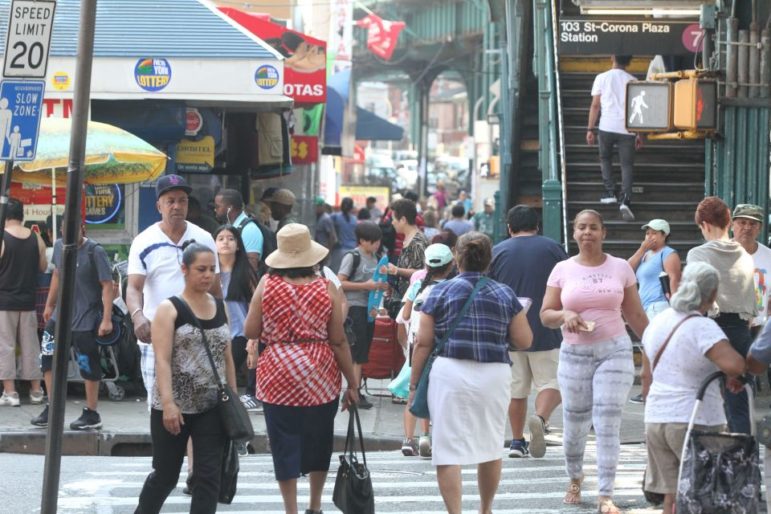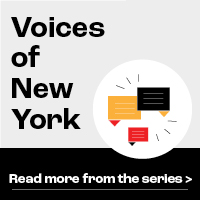The number of undocumented New Yorkers has dropped for three straight years. It’s a development with consequences for the local economy, some experts say.

Mariela Lombard
Unemployment among the immigrant community is at 50 percent.This article originally appeared in El Diario.
Translated by Carlos Rodriguez from Spanish.
Last week ended with terrible news for New York. As anticipated, the Senate failed to offer a new round of financial assistance, meaning that the already troubled budgets of the city and state will receive no federal funding.
The bad news is doubled, however, because the lack of federal aid does away with the possibility to help undocumented people, the most vulnerable among the immigrant population and one of the city’s mainstays. Undocumented people were already excluded from the direct assistance of the CARES Act, and do not qualify for social safety-net aid, such as unemployment benefits.
The positive contribution that this group and all those born abroad make to the local culture and economy is reflected in every statistic. It is particularly highlighted in the time of COVID-19 because of their role in professions considered essential work. For that reason, their troubles will be felt by the entire city, which has already seen a reduction in the undocumented immigrant population in the last 10 years. This could signify deeper complications for the city.
According to the Census Bureau, New York City recorded a decline of 45 percent among this sector of the population between 2016 and 2019.
A federal failure
Bitta Mostofi, commissioner of the NYC Mayor’s Office of Immigrant Affairs (MOIA), explains that “immigration plays a critical role in all aspects of the city’s economic, social and cultural life.” She added that over 3 million immigrants are part of the city’s workforce, and that half of all small businesses (48 percent) are owned by immigrants. They add some $232 billion, or 25 percent, of the city’s gross domestic product.
“When we talk about the greatness and growth of the city, we have to talk about the contributions of immigrants,” said Mostofi, referring to 2018 figures. She laments the federal government’s failure to effectively lead the effort to prevent and contain COVID-19, and to provide new relief legislation.
Mostofi’s office has verified that, since the Great Recession of 2008, the city’s non-immigrant and documented immigrant populations in the city have grown, while the number of undocumented people has gone down due to the policies implemented by the White House. In fact, updated figures for this year show that the arrival of immigrants in general has dropped since 2016.
This decline “is not insignificant, but for the moment has no major consequences,” she said.
Demographic researchers have pointed out that Donald Trump’s anti-immigrant policies and the obstacles he has created for immigrants have hurt this population and dissuaded prospective foreign students. “People are in shock to see how our country is reacting to the crisis and the pandemic. We have to do everything we can to invite temporary and permanent immigrants to come. This is a cause for concern, and the consequences will be severe if this perception does not change immediately,” said Mostofi.
Cyclical changes?
Jeremy Robbins, executive director of New American Economy, explained that immigrants were fundamental to the economic recovery after the last recession. “In 2008, New York recovered before any other place. If you walked down the streets of Jackson Heights, Bay Ridge or Astoria, no stores were closed because immigrants continued to open new businesses,” he said. Robbins admitted that, today, one of the biggest fears emerging from the COVID-19 crisis is that many businesses may never reopen.
“A recovery will require entrepreneurs and, in this sense, immigrants are critical, and they already own 48 percent of all small businesses,” said the director of the bipartisan organization, who advocates for the inclusion of immigrants.
Robbins is optimistic. He notes that, in the last three and a half years, several barriers have been set up to prevent people from other countries from coming to the U.S. to find opportunities to improve their lives. “They have made many changes to visa requirements, and there are countless obstacles for undocumented people, asylum seekers and refugees,” he said. However, he believes that the city still has much to offer if affordable housing rules are reformed and the arbitrary roadblocks imposed as part of the federal government’s anti-immigrant policy are eliminated.
According to Robbins, the decrease in immigration is cyclic, not linear. He admits that the current moment presents numerous difficulties for anyone born abroad, but concludes that it is the doctors; nurses; restaurant, salon and construction workers the ones who “make this city work.”
“If we have to think about how to activate the city’s magnetism, we are going to need the federal government to play a huge role in our economy, not just to sort out the obstacles but to create a path to obtaining legal status, entrepreneur visas – which are non-existent – and ways for people to be able to come out of the black market economy and make a living,” he said. “It is essential for people to have opportunities.”
Economic barriers grow
In the short and medium terms, these opportunities are scarce, largely due to the effects of a pandemic that may last a long time.
A MOIA report released in July estimated that unemployment among immigrant and undocumented communities in New York is above 50 percent.
These are also people who have limited access to the aid that community organizations have offered day laborers and their families or the city’s $20 million assistance fund, created in collaboration with financier George Soros’ Open Society, to provide checks to undocumented families.
Other organizations, such as NICE and La Colmena have requested more money from the city to help ease the need of many of the people they serve and for their food banks. However, the city’s budgetary restrictions have made this funding impossible to obtain.
Mostofi recognized California’s “tremendous effort” of creating a $125 million fund to send immigrants $500 checks. “Here, we are in need of the same type of effort. I intend to see how we can assist, but the context is a devastating economic crisis”, she said.
The same report explained that an estimated 366,000 undocumented immigrants are part of New York City’s labor force, of which 47,000 are business owners. Compared to an average of 36 percent among workers in general, 60 percent of all undocumented immigrants have lost their jobs or are at risk of doing so because of the pandemic.
MOIA estimates that, by the end of the year, the city may have around half a million jobs less than at the beginning of the year, half of them belonging to low-income workers. Opportunities to have a better life – the city’s magnet – need to be reactivated.









